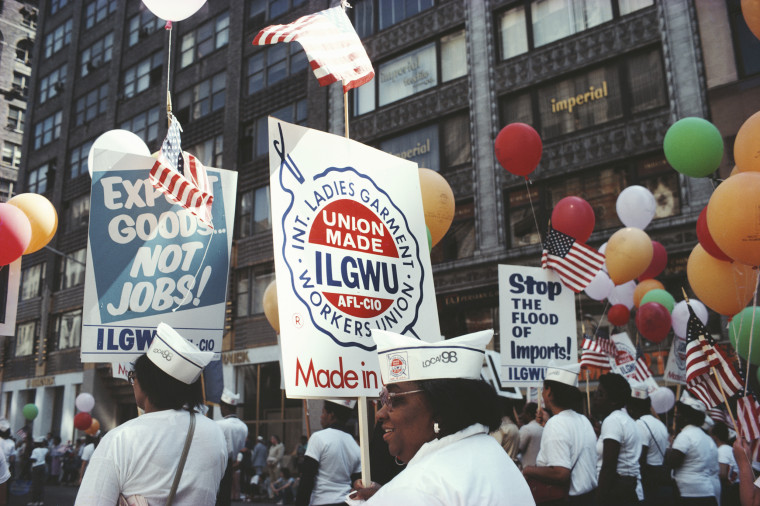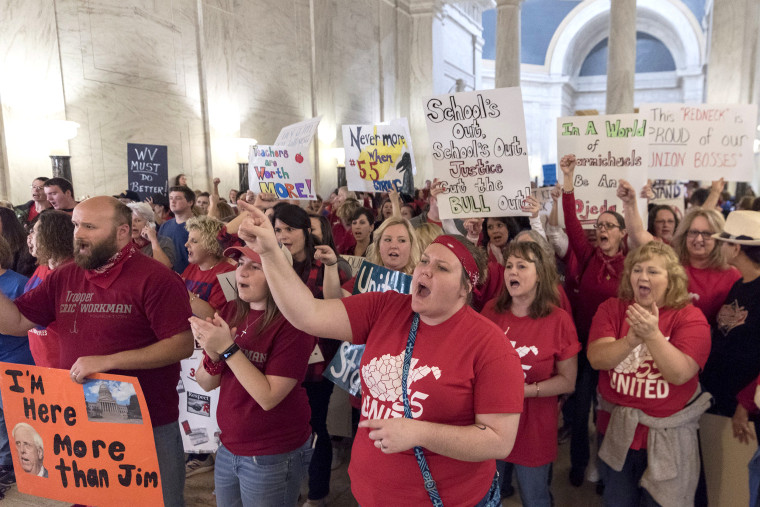In recent years, no Labor Day reflection on the state of the American working class could avoid one conclusion: Things are bad. Really bad. Unions are dying, strikes are nearly nonexistent, inequality is massive and widening by the day — all of these were true for Labor Days gone by, and all are true for Labor Day 2018.
But there is one thing of note this year, and it’s big: Some parts of the labor movement, particularly at the rank-and-file level, seem to have reached their breaking point. Because this year, they’ve started fighting back.
First, the bad news. After decades of decline, only 10.7 percent of U.S. workers are unionized. While 34.4 percent of public-sector workers are union, only 6.5 percent of their private sector counterparts are. The latter is an almost negligible number, and one on the verge of being decimated by anti-union forces anyway. At the same time, strikes, workers’ most powerful weapon, have become vanishingly rare. Making matters worse, some unions continue to avoid confronting crucial issues like racism head-on, failing to counter the President Donald Trump administration’s toxic, hollow xenophobic appeals to workers.
As the old-but-still-relevant joke goes: These days, the labor movement barely moves.
There is one thing of note this year, and it’s big: Some parts of the labor movement, particularly at the rank-and-file level, seem to have reached their breaking point.
Then, there’s Janus. The Supreme Court’s recent ruling in Janus v. AFSCME ended the public sector’s “agency fee,” a fee paid by workers who did not want to be members of their unions that covered the cost of representing them. Even if workers aren’t members, the union in their workplace is legally compelled to represent them (say, if a boss wants to discipline or fire them); the non-members are covered under the terms of the union contract, too, receiving the same wage increases and benefits as everyone else.
With Janus, public-sector unions may well go the way of the private sector, decimated to a single-digit unionization rate, with union activists forced to spend their time convincing members one by one to pay dues. This would leave in fewer and fewer resources for tackling shop-floor grievances or fighting for strong contracts. Which is exactly what the organizations who backed the plaintiff, Mark Janus, are hoping for.
Immediately after the Supreme Court ruled in Janus’s favor in June, the right-wing, anti-union apparatus sprang into action, with groups like the Freedom Foundation going door-to-door in states like Washington trying to convince union members to leave their unions. The foundation has plans to expand to California, Illinois, New York and Oregon.
U.S. labor law is so skewed in favor of bosses today that scholar Elizabeth Anderson calls the workplaces of America “arbitrary, unaccountable dictatorships” in which workers have few rights. In the wake of Janus, things will become even worse. And with egregiously anti-worker Judge Brett Kavanaugh likely to be confirmed for the Supreme Court, there’s no relief in sight.
That weakness of organized labor is reflected in the miseries of the U.S. working class as a whole. Most workers haven’t seen a raise in 40 years. With low wages and crushing student loan debt, many millennials will live worse lives than their parents, a reality reflected in their decision not to have children. Meanwhile, the costs of basic necessities — housing, health care, childcare — are rising. Inequality keeps increasing, as the few at the top pocket an ever-larger proportion of U.S. wealth. Add mass, cruel deportations, the erosion of reproductive rights and the steady persistence of police brutality, and it’s hard to deny that, especially for the poor and vulnerable, the foundations of a right to a free life are under attack.

Most of these things were true on Labor Day (a holiday which, it’s worth pointing out, was created to divert U.S. workers’ attention from May Day, the workers’ holiday with more militant roots that is celebrated nearly everywhere else around the world) last year. Unionization and strike rates were similar; unions knew Janus was just around the corner.
But this year, the mood of the U.S. working class seems to have shifted. After years of talking about how the rich have been the undisputed victors of the class struggle, many American workers have had enough.
This frustration is best illustrated by the teachers strikes that spread like wildfire early in the year — and haven’t stopped spreading. What began in West Virginia, with teachers going on an unlawful strike that occasionally defied their own union leadership, spread across the heartland to Oklahoma, Kentucky and Arizona, with educators striking for better pay and a reorientation of their states’ priorities towards investing in public education.
After years of talking about how the rich have been the undisputed victors of the class struggle, many American workers have had enough.
Summer break is over, but teachers are still striking. Teachers in one California town have already gone out on strike this school year. Seattle teachers recently threatened to walk off the job, passing a strike authorization vote on Aug. 28 before reaching a deal with their school district. They would have joined teachers in southwest Washington, some of whom have been on strike since mid-August. In Los Angeles, teachers just overwhelmingly passed a strike authorization vote, a response to deadlocked negotiations over raises, class size, over-testing of students and charter-school accountability.
Even in the private sector, there are signs that rank-and-file workers aren’t willing to sit by as their working conditions erode. In West Virginia, 1,400 communications workers struck while the state’s teachers’ strike was ongoing. And there’s a separate fight happening at UPS, where a contract covering the company’s quarter-million unionized workers is currently being negotiated. While the leadership of the Teamsters, which represents the workers, seems to want a “yes” vote on the proposed contract, a widespread campaign on the part of union reformers with the Teamsters for a Democratic Union and Teamsters United is pushing for a “no” vote, which would put the possibility of a UPS strike on the table.
Further, some prisoners throughout the country are currently on strike. Calling for an end to “modern day slavery,” they’re highlighting the 13th Amendment, which otherwise banned slavery, “except as a punishment for crime whereof the party shall have been duly convicted.” Prisoners laboring for little or no wages is common practice, and those on strike are demanding an end to it, along with nine other demands, such as rescinding the Prison Litigation Reform Act, the restoration of voting rights for incarcerated people and greater funding for rehabilitation services. While it’s hard to get exact details about what’s going on inside prisons, strike activity has been confirmed in multiple states, even as prison officials continue to issue denials.
This growing energy is also being articulated electorally. In Oklahoma on Aug. 28, a dozen Republican incumbents who refused to raise taxes to pay for teachers’ raises lost their seats in primary or runoff elections. At the federal level, Sen. Bernie Sanders is embracing the rhetoric of class war and has become a partisan in labor fights from Disney to Amazon (the latter of which felt compelled to release a statement pushing back against Sanders’s denouncement of their labor practices).
U.S. workers are hurting badly. But as long as bosses treat workers like garbage, there will be pushback.
And public opinion is moving in favor of both organized labor and pro-worker policies generally. Gallup poll results released on Aug. 30 found that despite the GOP’s efforts, 62 percent of Americans support unions, a 15-year high. A recent Reuters poll found 70.1 percent of respondents in favor of Medicare for All and 60.1 percent backing free college tuition.
All of this shouldn’t distract from many dire problems facing of the working class right now. U.S. workers are hurting badly. But as long as bosses treat workers like garbage, there will be pushback. And from West Virginia teachers to UPS delivery drivers, that pushback is catching on.
A few decades from now, maybe the flare-ups of 2018 will be a blip on the radar of the continued decimation of the U.S. working class. Or maybe we’ll look back on it as the year workers decided they wouldn’t take the beatings any more.
